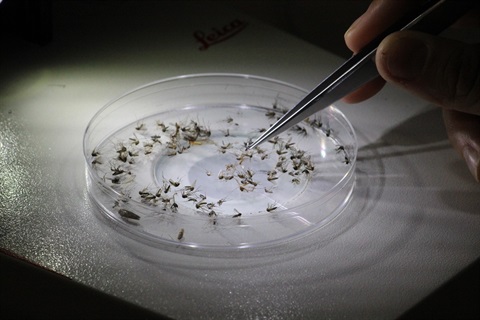Mosquito update
Published on 11 April 2022

What have we found?
Only four months into the year and we have already exceeded our annual rainfall of 623mm. Unexpectedly, we have not yet seen a large increase in mosquito activity, which is generally associated with the wet season. Monitoring of standing bodies of water for mosquito larvae and pupae has been ongoing, as has trapping for adult mosquitos.
Since the beginning of the year, trapping has been carried out by the Shire’s Environmental Health team on 6 occasions across 10 sites. At least 11 different species have been identified, with approximately 9000 mosquitos trapped!
Culex annulirostris – There has been a significant increase of Cx annulirostris around flooded grasslands and freshwater wetland areas, in particular in the basin between the northern end of Lullfitz Drive, through the northern end of the landfill and to Morrell Park.
High numbers of these mosquitoes were also identified at Roebuck Plains. Mosquito breeding on Roebuck Plains are possibly impacting properties at 12 Mile, and this may get worse as flood waters recede.
Aedes vigilax – This is often known as the saltmarsh mosquito. It is predominantly found breeding around the saltmarsh and mangroves around Dampier Creek. These mosquitos are strong fliers and are currently affecting properties around Roebuck Estate, Broome North, Morrell Park and 12 Mile, however prevailing westerlies help to keep these mosquitos away from the town site – easterly wind helps bring large numbers of these mosquitos into town!
Aedes notoscriptus – Ae notoscriptus is known as a backyard mosquito. It is a domesticated species and is often found breeding in containers holding water such as dog water bowls, tyres, pot plants or any other container holding water. It does not travel far from its breeding habitat, up to 200m. Recently it has been found to varying degrees at sites including Cable Beach, Roebuck Estate and Old Broome.
In addition, we have seen a range of other mosquitos with their own unique characteristics and which may present a nuisance problem. This includes Aedes normanensis, Aedes Macleaya, Culex pullus, Aedes alternans, Culex sitiens, Tripteroides punctolateralis, Anopheles meraukensis and Culex quinquefasciatus.
What are those massive mosquitos?
Occasionally we see a species called Aedes alternans, which will get your attention very quickly due to its impressive size, and shaggy striped appearance. They breed in saline/brackish ponds of water and the larvae have been found to be cannibalistic! It is not known to be a vector of any significant diseases.
What does this all mean?
Mosquito breeding in Broome is based on a diverse range of factors. Recent high heat may be limiting mosquito breeding, however there is still plenty of flood water around Roebuck Plains. There is still potential for an increase in mosquito numbers as we move towards the dry season. There is always a risk of mosquito-borne disease regardless of the time of year.
At home you can reduce the risk of localised breeding by ensuring there is no standing water. Dense vegetation also attracts mosquitoes as it provides a safe place for them to hide out of the wind and heat. Protect yourself by wearing long loose-fitting clothing and applying a DEET or Picaridin-based repellent.
Remember: repellent works like sunscreen, it only protects the sections of skin that it has been applied to. Always read the label.
Human disease risk
The risk of Kunjin Virus, Ross River Virus, Barmah Forrest Virus and Murray Valley Encephalitis remains active in the Kimberley. There is no cure for these diseases and avoiding being bitten is best. Some mosquitoes are also known to transmit heartworm to dogs.
Japanese Encephalitis Virus - To date there have been no detections of JEV in humans or animal hosts in WA. The Kimberley is seen as a potential entry point for JEV in Western Australia. The Shire of Broome is working closely with other local governments in the region and the Department of Health to prepare for and respond to the risk. As always, you should avoid being bitten as there is no cure for JEV.
The Department Primary Industries ad Regional Development is also playing a critical role in managing biosecurity. If you have any concerns regarding livestock, please contact DPIRD by clicking here.
For more information about what the Shire is doing following recent rain, click here.
For more information about mosquito management, please see the Mosquito Management Strategy here.